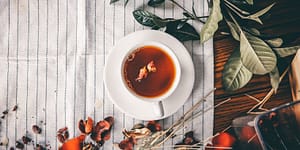Medicinal Uses for 8 Herbs Already in your Kitchen

We all know a dash of cayenne pepper is great on roasted sweet potatoes and a little bit of cinnamon goes a long way in a batch of cookies, but did you know many of the kitchen herbs already in your spice rack can also be used medicinally?
The following is an excerpt from Energetic Herbalism by Kat Maier. It has been adapted for the web.
Medicinal Uses for Common Herbs
Common kitchen herbs such as rosemary and ginger have been some of my most loved and used herbal allies. Every kitchen apothecary deserves these tried and true medicines. These are some of the first herbs I go to when I need an herbal hand.
All of the kitchen herbs discussed below (except cinnamon) can be grown in most locales, even in containers on an apartment windowsill or patio. While garlic might prefer to grow in a garden bed, I have known folks who grow it in containers on a city balcony with success.
1. Cayenne Capsicum frutescens, C. annuum
This red-hot spice needs no introduction, but there are so many medicinal uses of cayenne that it deserves our attention.
A South American native that was taken to Europe, its use spread rapidly, as its qualities were immediately appreciated. It has earned a reputation as a cure-all—its ability to enhance blood flow addresses so many issues.
When used in hot, tropical climes, this stimulant moves blood so well that it actually cools the body as it brings blood to the surface.
Healing Properties of Cayenne
Dr. John R. Christopher, founder of The School of Natural Healing, used it quite successfully for cases of angina.
Although angina is a very serious condition, in an emergency situation, this herb taken directly in powder form in water or tincture directly under the tongue, can stimulate circulation while medical help is being sought.
It can stanch bleeding if used topically but it will create a burning sensation. This is one of the easiest garden plants to grow and you will be stringing them or giving them away before you know it.
2. Chamomile Matricaria chamomilla, M. recutita
While not generally considered a culinary herb, chamomile offers so many benefits that every kitchen should have a supply on hand. As a digestive bitter, chamomile is excellent for all types of digestive complaints. It is calming and soothing for inflammation.
It contains antioxidants, and thus a cup of chamomile tea is a general healthful beverage. Applying a tea bag on a sty or inflamed wound is a great antimicrobial as well as astringent.
Matricaria chamomilla (also called Matricaria recutita) is the preferred medicinal species rather than Roman chamomile (Chamaemelum nobile).
3. Cinnamon Cinnamomum cassia, C. verum
This warm, pungent, aromatic bark is a wonderful stimulant for digestion as well as circulation. Traditionally, the cooler months were greeted with the aroma of cinnamon added to cooked fruits or added to milk as a warming, relaxing sleep tonic.
Such a common kitchen spice, yet a complex and revered medicine. There are actually two types of cinnamon to consider.
Cinnamomum cassia, or Cassia cinnamon, is the most common one we find in commercial spices and is pungent and spicier. C. verum (also known as C. zeylanicum) is considered the preferred cinnamon and has the common name of Ceylon cinnamon. This variety is sweeter.
Healing Properties of Cinnamon
Research shows that consumption of either bark increases the production of insulin by the pancreas, thus lowering blood sugar for type 2 diabetes. If you plan to take larger quantities, such as 1⁄2 teaspoon of bark powder two to three times a day for medicinal purposes, it is best to work with Ceylon cinnamon.
No matter which species, though, sprinkling cinnamon into tea blends, coffee, and rice dishes is a healthy way to spice up our lives. This spice is wonderful in savory dishes as well, especially winter soups.
4. Garlic Allium sativum

To get the benefit of its antimicrobial actions, though, it’s necessary to eat garlic raw or very close to raw. A favorite method is to mince a clove (if you have never eaten raw garlic, start with a small amount and work your way up) and add that to a teaspoon of honey.
The honey also is a medicine and it protects the stomach if the heat of garlic is too upsetting. The honey also is a medicine and it protects the stomach if the heat of garlic is too upsetting.
Healing Properties of Garlic
While the odor of garlic on the breath can be bothersome to others, it is evidence that the volatile oil has reached the lungs and the medicine is doing its work.
This food strongly transforms and expels damp stagnation from the lungs and digestive tract.
As a cooking spice, garlic is wonderful for digestion; it even contains inulin, a prebiotic that is necessary for good intestinal flora. The myth that eating too much garlic can wipe out gut flora is just that—a myth. Unless, of course, you consume several entire bulbs in one session!
Garlic works as an amphoteric for balancing high and low blood pressure. Aged garlic capsules can be effective for treating this condition, but the preferred form for most other applications is as a food, preferably fresh.
5. Ginger Zingiber officinale

Fresh ginger is one of the most important herbs in Chinese medicine for treatment of wind cold in patients with tissue depression or weak defensive energy (feeling run down).
Dried ginger is hotter and more intense, so I freeze organic fresh ginger.
Freezing Ginger
It keeps well frozen for at least six months, so it’s a good method for ensuring you always have some fresh herb available. If the root is large, break it into smaller pieces and place in a well-sealed container.
Ginger root is very easy to peel and grate when it is frozen. (Peeling is not necessary if it is organic.) Many healing herbs are cool in nature, and adding ginger to a blend warms up the formula.
Adding Ginger to Formulas
The addition of fresh or dried ginger to a formula keeps the herbs in the system longer as well, helping to be sure the medicine permeates to the extremities. Dried ginger powder makes an excellent paste to apply to sinuses or areas of the body you want to warm.
Be mindful that it will bring blood quickly (desired action) and that you may need to take off the paste in 10 to 20 minutes. To make a paste simply add a small amount of warm water slowly to powder, mix well, and when the consistency is right, apply to the face near the cheekbones.
Healing Properties of Ginger
Ginger is possibly best known for reducing nausea of morning sickness, motion sickness, or nausea arising after consuming a heavy meal.
Ginger works by warming the stomach, which settles queasy feelings. As an acrid herb, it reduces spasms internally and externally.
There is nothing so divine as a fresh ginger bath. Make a very strong ginger tea by grating half a fresh ginger root into a two-quart pan, add cool water, bring to a boil, then simmer for an hour. Strain this, add to bathwater, then slip into a warm, relaxing realm. Ginger deeply penetrates tense muscles.
6. Rosemary Salvia rosmarinus

Healing Properties of Rosemary
(Rosmarinic acid is also found in many other plants.) Rosemary is a wonderful stimulating tea for enhancing memory, alertness, and for clearing headaches.
It is a strong-tasting herb, so blend well with other herbs, or you can make a tea rather than a strong infusion.
It is my go-to remedy to clear pink eye as well as skin infections. It works particularly well for thrush and fungal infections. Rosmarinus, rose of the sea, makes a beautiful, aromatic topical oil for chest congestion.
Its antioxidant properties are seen in the way this wonderful ally lasts and keeps its potency in our spice racks.
7. Sage Salvia Officinalis
Sage is an unsung heroine of our spice cabinets. This lack of favor might be due to its astringent taste, but this plant held center stage in ancient times. Its power is evident even in its name—salvia means “to save” in Greek.
This culinary herb is so drying that nursing mothers are advised to use this tea if they want to cease milk production. This same astringing power makes this my number one remedy in working with sore, swollen throats.
Healing Properties of Sage
I use it in a throat spray, a gargle, or a tea with honey and lemon. Used as a mouth rinse, sage is wonderful for all inflammation of gums and the mouth.
Highly aromatic, sage contains antioxidants and other compounds that support immune function when working against microbes. As the name implies, it has been used for centuries with elders to promote memory and cognitive health.
8. Thyme Thymus vulgaris
One of the easiest culinary plants to cultivate, this humble, low-growing herb is one of the hottest and most penetrating of spices. Thyme is a very powerful medicine for all kinds of infections but especially those in the respiratory and digestive systems.
Healing Properties of Thyme
Due to its intensity, it is the perfect remedy for cold, thick, phlegmatic bronchial conditions. As a specific for whooping cough, this medicine is coming back into the limelight in a time when antibiotic-resistant strains are challenging our immune systems.
As a topical, thyme is wonderful for clearing fungal infections as well as wet, oozing skin conditions. A favorite steam inhalation is a blend of thyme, sage, and rosemary.
Recommended Reads
Recent Articles
Want to start your own medicinal herb garden? Passionflower, lemon balm, and goldenseal are great places to begin! These herbs are jam-packed with medicinal properties and easy to grow in a majority of climates.
Read MoreSprouts are easy to cultivate, mature quickly and pack a nutritional punch! You can make nutrient-rich sprouts from all kinds of edible seeds in your kitchen.
Read MoreSuffering from frequent headaches is miserable and immobilizing. If you haven’t had luck treating and preventing your headaches, skip the over-the-counter approach and prepare herbal formuals for migraines to use in the future! The following is an excerpt from Herbal Formularies for Health Professionals, Volume 4 by Jill Stansbury. It has been adapted for the…
Read More“It is more important to know what kind of person has a disease than to know what kind of disease a person has.” —Hippocrates Drawing on her decades of clinical experience and her extensive research, Dr. Jill Stansbury offers an unparalleled range of herbal formulas in her five-volume set, Herbal Formularies for Health Professionals. For each…
Read More








